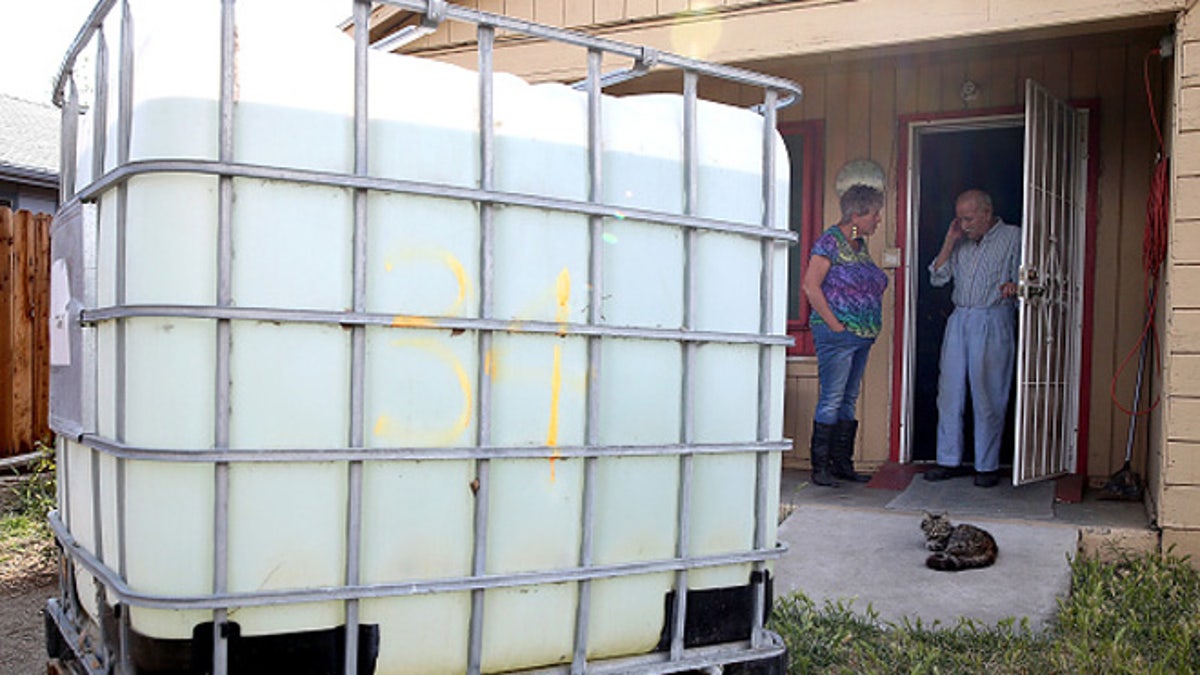
(Photo by Justin Sullivan/Getty Images) (2015 Getty Images)
While the water crisis in Flint, Michigan, made headlines around the country when the city's leaders exposed residents to a tainted water supply for almost two years, families living in the Central Valley of California have been struggling without clean drinking water for decades.
The population of the Central Valley, a basin surrounded by mountains that once offered hope to migrants like the fictional Joads in the “The Grapes of Wrath,” today is about 80 percent Latino, and 92 percent of the migrant farm workers in the Valley are Latino.
There are vast dairy farms reeking of manure, highways lined with fast-food restaurants, liquor stores, prisons and numerous dialysis centers.
Much of fruits and vegetables consumed in the U.S. are grown here, and the soil has been decimated by agricultural activity – overuse of fertilizers and pesticides, manure from livestock. One result is a toxic soup of nitrates in the area's drinking water.
Residents in towns along the San Joaquin Valley rely predominantly on pumps and ground water – which is not effectively regulated for contamination.
When pumped up into people’s homes, the nitrates are so dangerous that people are known to get rashes when they shower. The presence of nitrates in the water supply also has been linked to “blue baby syndrome,” which is caused by the decreased ability of blood to carry oxygen – one of the most common causes is nitrate in drinking water.
People turn to buying five gallon jugs to shower with and using 300-gallon tanks of non-potable water for basic needs.
“Generations of people who live here know not to drink the water,” Susana De Anda, a clean-water advocate and the co-executive director and co-founder of the Community Water Center NGO, told Fox News Latino.
“People pay more for this ‘toxic water’ – sometimes as much as $100 a month for water just to shower with. On top of that they’re paying for drinking water,” De Anda said.
According to the Environmental Justice Coalition for Clean Water, rural Central Valley communities pay the highest drinking water rates in the state, with some families shelling out as much as 2 to 6 percent of their income for water that they can’t drink.
According to a Pacific Institute report, nitrate exposure's health impacts in the Central Valley fall disproportionately on poor Latino communities.
Due to the state’s severe drought, new wells have to be dug more deeply, demand is high and the cost is between $1 million and $2 million dollars.
"The drought actually causes the pollutants in the soil to be more concentrated and levels of contaminants such as nitrates to rise. Also, when deeper wells are dug, and that would be by maybe wealthier farmers, they actually end up syphoning water away from poor communities," Genoveva Islas – program director at Cultiva la Salud ("Cultivate Health"), a non-profit health advocacy organization in the Central Valley – told Fox News Latino. "And it creates a real inequity."
Most people in the area live a large distance from the closest big grocery store. Liquor and convenience stores become the default place to buy food and produce, and, all too often, sugary drinks are less expensive than drinking water.
"We’re in a food desert. People would buy water in bulk, but big stores are often very far outside of communities, and so families make a tough trade-off. Soda might be more affordable,” De Anda said.
In addition to other factors, the consumption of soda vs. water is one of the leading reasons for the severe health problems in the Valley. The region has big problems with obesity and the highest rate of Type 2 diabetes in the state.
An analysis of state's death records by the Fresno Bee and the Center for California Health Care Journalism at the University of Southern California paints a vivid picture of the disproportionate toll diabetes has taken in the Valley.
At least 19 people die from diabetes-related complications in the eight San Joaquin Valley counties every day, the highest rate in the state.
"I've lived here all my life, and not until I was an adult was really aware of dialysis clinics. Now, I have an aunt and a close family friend who are both on dialysis. I'm seeing a number of these [places] pop up. More than ever before," Islas says.
The Central Valley may be the fruit and veggie center of the country, but for poor people healthy food is still significantly more costly than food sold in bulk, such as beans, rice, tortillas, white bread, ground beef and large bottles of soda. Many of the stores in the Valley offer free soda with groceries, and a small bottle of water runs about $1.69 versus a large soda at .99 cents.
In the last three years, the state has paid to retrofit water filters on drinking fountains in some pockets of schools and daycare centers, and provided filtered bottle stations, where people can fill-up containers. But Islas says it's not universal.
"There's still a lot of marketing of sugary drinks to kids, which in addition to diabetes and obesity, dental health problems. In Flint, the Governor has set aside money for the kids impacted by the lead, but in the Central Valley, we have the same issues of long term health problems for impoverished kids. We use education as a pathway out, but if you're thirsty or you have health concerns, it's pretty hard to learn," Islas says.
The drought in California may be shining a light on the region and its water supply, but the issues in the Valley have been left largely unaddressed.
“All these are interim solutions, but we also need to create water awareness. The water may look clean, but that doesn’t make it safe. It shouldn’t matter who you are or where you live, clean drinking water is a basic human right,” De Anda says.
